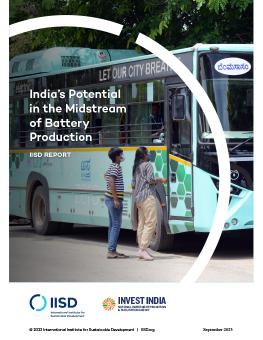
India's Potential in the Midstream of Battery Production
Strategies to create a globally competitive EV ecosystem in India
India could become a hub for electric vehicle (EV) manufacturing and recycling with the right incentives and government policies that can meet strong domestic demand for EVs and take advantage of the growing manufacturing sector. This report summarizes consultations with over 25 companies and actors to determine what factors are crucial in the considerations of companies on where to invest in and expand manufacturing.
In India, transportation currently accounts for 14% of greenhouse gas emissions. With over 300 million vehicles currently on the road and 200 more million to be added in the next two decades, India faces a massive challenge to electrify its road vehicles and reach its goal of net-zero by 2070. However, this challenge also provides India with a tremendous opportunity. As the 4th largest producer of automobiles, the transition to EVs provides a huge economic opportunity if India localizes EV and battery manufacturing.
India could become a hub for EV manufacturing and recycling with the right incentives and government policies that can meet strong domestic demand for EVs and take advantage of the growing manufacturing sector. India can immediately become a vital segment of the battery supply chain by producing battery cells and expanding mineral processing. This report summarizes consultations with over 25 companies and actors to determine what factors are crucial in the considerations of companies on where to invest in and expand manufacturing.
This report gives an overview of India’s targets and current state of play and then discusses battery supply chain fundamentals that need to be critically assessed to understand where India has the strongest comparative advantage. It closes by outlining key companies’ decision-making factors and assesses India’s potential comparative advantage against each factor.
You might also be interested in
Lithium-Sourcing Roadmap for India
This report aims to provide a strategy to guide policy-makers in sourcing lithium responsibly to promote clean energy manufacturing in India, with the broader aim of supporting low-carbon economic growth, creating equitable jobs, and helping to mitigate climate change impacts.
G20 Summit Agreement Fails To Strengthen Coal Phase-Down Even As Data Show High Per Capita Coal Emissions
As world leaders gather in New Delhi for the Group of 20 (G20) Summit–with 19 member countries and the European Union–data show that a majority of the group still has very high per capita coal power emissions. At the summit, countries agreed to "pursue further efforts" to limit the global average temperature rise to 1.5 degrees celsius, agreeing to "encourage efforts to triple renewable energy capacity globally" but the G20 New Delhi Leaders Declaration included no new commitment on phasedown of coal power or on phasing down all fossil fuels.
Public Financial Support for Renewable Power Generation and Integration in the G20 Countries
G20 governments provided at least USD 168 billion in public financial support for renewable power in 2023, less than one third of G20 fossil fuel subsidies that year.
Senegal's Big LNG Gamble
This report explores Senegal's nascent liquefied nitrogen gas (LNG) industry by assessing the impacts associated with a new fossil fuel-based industry on the country's environment, economy, and society. It does this by responding to three questions: What have been the impacts of the development of LNG on Senegal to date? Is it viable for Senegal to invest further into an industry that is projected to decline? What risks can Senegal expect should it forge ahead with its LNG development plans?